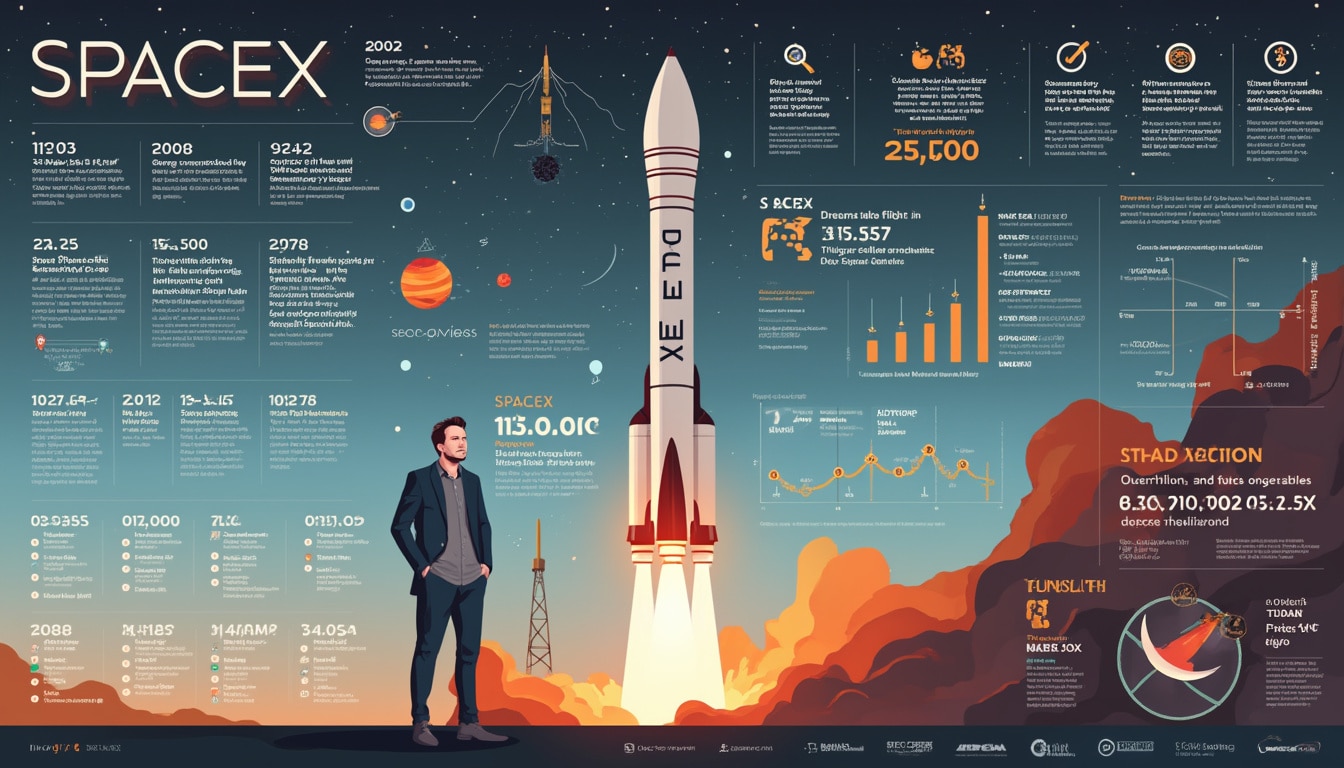SpaceX has emerged as a pivotal player in the aerospace sector, revolutionizing how we view space travel and exploration. Founded by Elon Musk, the company has consistently pushed boundaries, making the dream of regular space travel a burgeoning reality. Owning a piece of such an innovative company has become a tantalizing consideration for investors and the public alike.
The notion of investing in SpaceX goes beyond traditional stock market transactions; it’s about participating in a vision that aims to colonize Mars and enhance human existence through technology. The appeal extends to the potential financial returns, especially as the company prepares for its IPO, which promises to open doors for many. However, with opportunity comes understanding the costs involved in this endeavor, both for investors and for the broader implications of commercial space travel.
The Financial Landscape of SpaceX: A New Era of Investment
Investing in aerospace, specifically in a company like SpaceX, is vastly different from traditional stocks. Elon Musk’s approach to business emphasizes innovation and disruption, resulting in a need for capital that drives the financial structure. SpaceX’s unique funding model involves private investments, which have been crucial to its rapid growth and success. The company’s valuation has soared, indicating strong market confidence but also raising questions about the sustainability of this growth.
The cost of ownership isn’t merely about purchasing shares; it requires an understanding of capital investment, usage of resources, and potential returns. SpaceX has made headlines for its cost-effective launch solutions, such as the Falcon Heavy, which highlights its competitive edge in the aerospace market. The costs associated with investing in such technology often reflect broader industry trends and potentially lucrative prospects.

Understanding SpaceX’s Model: A Game Changer in Aerospace
The revolution that SpaceX brought to the aerospace industry lies significantly in its approach to construction and launch. For instance, the cost per kilogram to launch payloads has dramatically decreased. From an estimated $60,000 per kg on the Space Shuttle to around $1,300 per kg via SpaceX’s Falcon Heavy, the implications for commercial space travel are monumental. This transformation reflects not only on SpaceX’s profitability but also on its attractiveness to investors.
Many industry analysts are keen to explore how this model can continue to impact space exploration and tourism sectors. The movement towards cheaper space access opens doors to small businesses and research institutions that may have found such ventures prohibitively expensive in the past. Understanding that this cheaper access is not just a commercial advantage but a revolutionary breakthrough is crucial for prospective investors.
The Role of Investors in SpaceX’s Future
Investors play a crucial role in not just funding, but in shaping what’s possible at SpaceX. The infusion of capital is essential for driving ambitious projects. In recent years, SpaceX has opened its doors to a broader range of investors, increasing participation and allowing everyday individuals to become part of the space revolution. Understanding the motivations for such investments—from the allure of innovation to the financial backstories—is pivotal.
The global perspective on space valuation continues to evolve. As more private entities enter the aerospace arena, the traditional definitions of ‘ownership’ and ‘value’ will also shift. Stakeholders must prepare for a future where equity in space ventures blends public interest with private gains, ensuring that democratization of access to space benefits both investors and explorers alike.
The Future of Space Travel: Opportunities and Challenges
Looking ahead, the question of space tourism and exploration’s costs becomes paramount. With Elon Musk spearheading initiatives aimed at making space tourism a viable option, interest in ownership has surged. The excitement around commercial missions to Mars and beyond is palpable. However, the execution of these ambitious plans involves not only technological challenges but also significant financial investments.
Many are eager to understand what it will cost not just to invest but to experience space firsthand. The landscape is shifting, and with it, the pricing structures for tickets and missions. Is it worth the hefty investment? This question underlies much of the debate within the space community, as the figures associated with early missions could set vital precedents for the future.

Balancing Innovation with Practicality
The concept of space tourism has captured imaginations but comes with practical considerations. Individuals must evaluate not only their interest and financial capacity but also the readiness of the market. Companies like SpaceX will need to address public fears concerning safety, the environmental impact of launches, and the overall feasibility of regular tourism into space. This includes engaging in educational campaigns to bring awareness and understanding of this new industry.
The cost of launching missions, both financially and environmentally, is a topic of intense discussion. As the debate on sustainability in space travel heats up, prospective investors and tourists alike will need to weigh the costs against ethical considerations. How do we ensure space remains a frontier for all, rather than a playground for the affluent? These questions are vital as we explore the future landscape of space, innovation, and investment.
Investing in SpaceX: Understanding Returns and Risks
The prospect of owning a piece of SpaceX is enticing, yet it necessitates a thorough grasp of potential returns and associated risks. As with any investment, understanding the market dynamics and projected growth is essential. Whether investing through direct equity or alternative means, maintaining real-time awareness of developments in the space industry is crucial.
Current projections estimate considerable ROIs for early investors, especially if SpaceX continues its upward trajectory. This sentiment is echoed in discussions about the upcoming IPO and what it could mean for investors. To navigate this landscape successfully, one must balance optimism with a pragmatic view of the sector’s fluctuations.

Strategies for Potential Investors
Building a strategy for investing in a company like SpaceX involves several thoughtful considerations. Firstly, prospective investors should conduct extensive research, understanding not only the company’s trajectory but also the broader market trends in space technology and exploration. Leveraging insights from previous investments in other sectors can also provide beneficial context.
Engaging with seasoned investors or finance professionals can yield invaluable advice tailored for navigating this emerging field. Understanding the any political and social ramifications of space travel could give investors the edge needed to make informed decisions. Creating a diversified portfolio that includes different areas of space exploration could also mitigate potential risks and foster growth.
Conclusion: A New Frontier in Investment Opportunities
Owning a part of Elon Musk’s SpaceX opens a thrilling avenue of investment that weighs both promise and responsibility. Those looking to become part of this space renaissance must grapple with the financial, ethical, and environmental implications of their investments. The allure of space exploration remains potent, but it will require diligence, vision, and ongoing dialogue about the future possibilities that await.




Leave a Reply